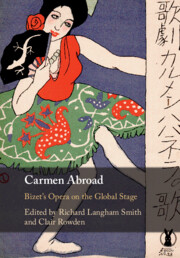Book contents
- Carmen Abroad
- Carmen Abroad
- Copyright page
- Contents
- Figures
- Tables
- Preface
- Acknowledgements
- Notes on Contributors
- Part I Establishment in Paris and the Repertoire
- Part II Across Frontiers
- Part III Localising Carmen
- 17 Russian Carmens and ‘Carmenism’: From Imperial Import to Ideological Benchmark
- 18 The Other Reversed? Japan’s Assimilation of Carmen, 1885 to 1945
- 19 Flamenco and the ‘Hispanicisation’ of Bizet’s Carmen in the Belle Epoque
- 20 Carmen at Home: Between Andalusia and the Basque Provinces, 1845 to 1936
- 21 Carmen in the Midi Amphitheatres: A ‘Tauro-Comique’ Spectacle
- Selected Bibliography
- Index
- References
18 - The Other Reversed? Japan’s Assimilation of Carmen, 1885 to 1945
from Part III - Localising Carmen
Published online by Cambridge University Press: 18 September 2020
- Carmen Abroad
- Carmen Abroad
- Copyright page
- Contents
- Figures
- Tables
- Preface
- Acknowledgements
- Notes on Contributors
- Part I Establishment in Paris and the Repertoire
- Part II Across Frontiers
- Part III Localising Carmen
- 17 Russian Carmens and ‘Carmenism’: From Imperial Import to Ideological Benchmark
- 18 The Other Reversed? Japan’s Assimilation of Carmen, 1885 to 1945
- 19 Flamenco and the ‘Hispanicisation’ of Bizet’s Carmen in the Belle Epoque
- 20 Carmen at Home: Between Andalusia and the Basque Provinces, 1845 to 1936
- 21 Carmen in the Midi Amphitheatres: A ‘Tauro-Comique’ Spectacle
- Selected Bibliography
- Index
- References
Summary
Carmen is currently one of the most frequently performed Western operas in Japan where the character of Carmen has become widely known. This chapter explores the complex processes of assimilating and integrating a Western icon into the culture of a Far-Eastern country. It begins by establishing a chronology of performances and adaptations of Carmen in Japan between 1885 and 1945, and examines in detail: 1, the first performance of the opera by a Russian company in 1919; 2, the first all-Japanese-cast production in 1922; 3, the contribution of mixed-race singers such as Yoshiko Sato (1909−1982) and Yosie Fujiwara (1898−1976); and 4, Japan’s eventual role as a disseminator of occidental music to other Asian countries.
These encounters between Carmen and Japan raise fascinating issues of race, gender, class, hybridity and proto-globalisation. By embracing the ‘Otherness’ of Carmen, the Japanese were not asserting their distance from the West but rather attempting to access its mainstream. In this way, by striving to incorporate its Western ‘Other’, Japan embarked upon a shift towards a globalised world.
Keywords
- Type
- Chapter
- Information
- Carmen AbroadBizet's Opera on the Global Stage, pp. 284 - 303Publisher: Cambridge University PressPrint publication year: 2020
References
Newspapers and Periodical Literature
Asahi Newspaper (Tokyo)
L’Écho du Japon (Yokohama)
The Independent-Record (Helena, MO)
Keijo Nippō Newspaper (Seoul)
Miyako Newspaper (Tokyo)
Monthly Gakufu (Tokyo)
The Musical Courier (New York)
The Musical Times (London)
The New York Times
Ongaku no tomo
Ongaku shincho
Ongaku to bungaku
Philharmony (Tokyo)
Yomiuri Newspaper (Tokyo)



